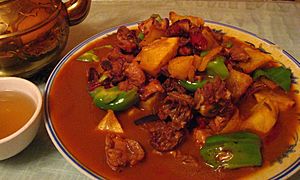Dapanji facts for kids

Dapanji is a super tasty chicken stew from Xinjiang, China. Its name means "big plate chicken" in Chinese, and it's usually served on a really big plate! It's also known by its Uyghur name, toxu qordiqi. This dish is very popular and is enjoyed by many people across China.
What's in a Name?
The name Dapanji means "big plate chicken" in Chinese. In the Uyghur language, it's called toxu qordiqi. This name also means "big plate fried chicken".
How Dapanji Became Popular
Dapanji became very popular in Xinjiang in the mid-1990s. People say it was first made in a place called Shawan County in Northern Xinjiang. A person from Sichuan province, known for its spicy food, created it. They mixed hot chili peppers with chicken and potatoes to make a dish that tasted like home.
Even though many believe Shawan is where it started, others think it was invented near Ürümqi by someone from Hunan province. At first, the dish might have been served on several smaller plates. But soon, people started using one large plate, which gave the dish its famous name.
This dish became a favorite for truck drivers traveling along the highways in Xinjiang. It was a quick and filling meal that tasted great. Because it was so flavorful and hearty, Dapanji quickly spread from Xinjiang to the rest of China.
What's in It and How It's Made
Dapanji is made with simple but delicious ingredients. The main ones are chicken, bell peppers, and potatoes. It also includes onions, garlic, ginger, and chili peppers for a spicy kick. Spices like ground cumin, star anise, and ground Sichuan peppers add even more flavor. Sometimes, soy sauce and beer are added too.
To make it, the chicken is cut into small pieces. These pieces are cooked with the spices and chopped vegetables. Then, everything simmers in a broth, making a rich and spicy stew.
Dapanji is usually served with laghman noodles. These are wide, hand-stretched noodles that are perfect for soaking up the tasty sauce. Families and friends often share this dish together.
Sometimes, Dapanji is also served with nan, which is a type of flatbread popular in Xinjiang. When the nan soaks up the sauce, it becomes soft and moist, making it extra delicious!
See also
 In Spanish: Dapanji para niños
In Spanish: Dapanji para niños

